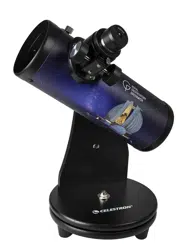Loading ...
Loading ...
Loading ...

ENGLISH | 17
Galaxies
A galaxy is an immense system of millions or billions of stars along with gas and dust that are gravitationally bound
together. Most galaxies range from 3,000 to 300,000 light years in diameter and are separated from each other by vast
distances of millions of light years. If you have gone outside on a dark night and seen the Milky Way stretching across
the sky, you are seeing the disk of our galaxy—from the inside. Distant galaxies are very faint can only be seen under dark
skies with fully dark-adapted eyes. Most will appear as elongated smudges of light in the eyepiece. To see hints of the
delicate spiral structure in most galaxies, you need a very large telescope with a diameter of at least 11 inches (280 mm).
Observing the Andromeda Galaxy
The Andromeda Galaxy is spiral galaxy that lies approximately
2.5 million light years from Earth in the constellation
Andromeda. It contains over a trillion stars, double the amount
in our own Milky Way galaxy. It is the only distant galaxy visible
to the naked eye on a dark, moonless night. The Andromeda
Galaxy is currently on a collision course with our Milky Way
Galaxy, traveling towards us at close to 200 miles per second
(315 km/sec). The collision is expected to occur in about 4
billion years, when both galaxies will possibly merge to form
one giant elliptical galaxy.
Because the Andromeda Galaxy is such a large object, it’s
best viewed using a low power eyepiece. In long exposure images of this galaxy, the galaxy can take up 3 degrees of
sky, or 6 times the diameter of the full moon. However, in most telescopes, only the bright central core is visible. When
starhopping to this object, you will find the constellation Andromeda does not have many bright stars. An excellent
starting point is with the 5 bright stars of the nearby constellation of Cassiopeia, which is shaped like the letter W (or M
depending on the season or time of night).
PRACTICE WHAT YOU HAVE LEARNED: OBSERVING GALAXIES
Loading ...
